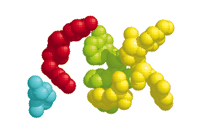Sites of interest on the World Wide Web—edited by Rick Neubig and David Roman
Database of Biological Processes— The Reactome
The Reactome Project (www.reactome.org) is a curated database provided through collaboration among the Cold Spring Harbor Laboratory, the European Bioinformatics Institute, and the Gene Ontology Consortium. This Web site offers information about a wide variety of biological pathways, ranging from basic metabolism to hormonal signaling. The database is referenced with literature citations and is subject to peer review prior to release.
The Reactome database is the successor to the Genome Knowledgebase and features a unique concept for presenting the interrelations and connections between individual parts of a biochemical pathway. The concept, referred to as “starry sky,” presents biological pathways as a series of constellations. The ability to navigate through this virtual universe of connected processes allows for visualization of the connections between pathways, demonstrating that no process occurs in a cell without a series of other cellular processes being affected.

One of the truly unique features of this database involves the pathfinder tool. In this interface, you can enter a starting point (your favorite protein, for example) and a cellular event, such as intracellular Ca2+ release. Simply input the start and endpoints, and a text and graphical map of the pathway is presented, including clickable descriptors to each player in the process. This could be a very useful tool for examining an unpredicted experimental observation, and the generated graphical pathway maps are great for visual examination of the process.
The Ki Database—NIMH Psychoactive Drug Screening Program
The National Institute of Mental Health Psychoactive Drug Screening Program (NIMH PDSP), directed by Dr. Bryan Roth at Case Western Reserve University, has made a database available containing over 31,000 entries for ligand affinities (http://pdsp.cwru.edu). The database is searchable by receptor, species, source tissue, radioligand name, test ligand name, reference, and Ki range. A typical search for a receptor of interest results in a list of ligands, including PubChem references, primary literature references, Ki value, and experimental information, such as the tissue and species type, as well as the identity of the radioligand used for the binding study. This database provides a wealth of information for those interested in receptor pharmacology. Furthermore, this Web site also offers information about the Psychoactive Drug Screening Program in general, another valuable resource for investigators.

Online Teaching Tool for Basic Pharmacology
The Pharmacology Education Partnership (www.the-pepproject.net) is a collaboration among the Duke University Medical Center, the North Carolina School of Science and Mathematics, and biology and chemistry teachers across the United States. This Web site focuses on the mechanistic pharmacology of drugs of abuse. The project, funded by the National Institute on Drug Abuse (NIDA), provides students and teachers with dynamic presentation material for concepts such as steroid mechanisms, free radical–mediated neuronal damage, drug testing, and natural products. Currently, six modules are online, and besides the content, the quality of the Flash animation alone makes this site worth a visit!
- © American Society for Pharmacology and Experimental Theraputics 2005




